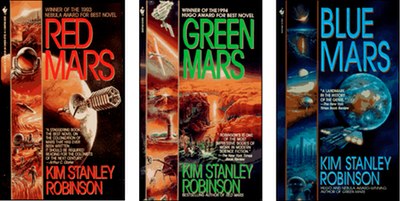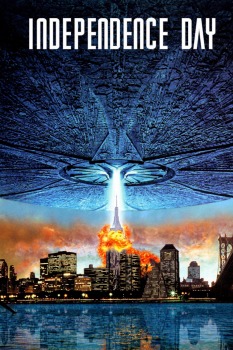
Despite the fall of the Soviet Union, and the beginning of the end of the Communist experiment, the world of the 1990s was still rife with conflicts and tragedies. Formerly Soviet nations struggled to find order in their new freedom, and ethnic conflict in places like Rwanda and Bosnia led to mass genocide. The situation in the Middle East continued to be tense. In spite of these tumultuous events, however, the 1990s were a time of great multicultural reconciliation in other places. For example, in 1998, the Good Friday Agreement ended thirty years of violence between Protestants and Catholics in Northern Ireland.
Computer technology was completely revolutionized with the advent of the World Wide Web, which has affected the course of education, entertainment, and social interaction ever since.
Science Fiction:
Literature-

Kim Stanley Robinson began his award winning Mars Trilogy in 1993 with Red Mars. The novel and its sequels- Green Mars (1994), and Blue Mars (1996)- as well as an anthology set in the same universe- The Martians (1999)- describe a future history in which humans terraform and colonize mars.

Permutation City was released by Greg Egan in 1994. It explored concepts of virtual reality, and uploading human consciousness, and won the John W. Campbell and Philip K. Dick Awards in 1995.

The next year, Neal Stephenson published The Diamond Age- the story of a girl in the lowest class of society raised by an interactive book intended for an upper-class child. It won the Hugo and Locus Awards in 1996.
.jpg)
Mary Doria Russell won the Arthur C. Clarke and British Sci-fi Association Awards, (among others), for her 1996 novel, The Sparrow. In it, a Jesuit priest is the sole returnee from an expedition to investigate music coming from the Alpha Centauri area. She followed it up in Children of God, published in 1998.
Television-

A wildly popular television incarnation of Batman, produced by Warner Brothers, and run by Bruce Timm and Eric Radomski premiered in 1992. Though it was geared towards young audiences, it held to the dark mood, and many of the important plotlines of the comic books. The show was the first in a long string of DC Comics animated shows, including Superman (1996), Batman Beyond (1999), Justice League (2001), and Justice League Unlimited (2004).

The X-Files, a crossover between science fiction, paranormal/horror, and government investigation television was first broadcast in 1993. It starred Gillian Anderson and David Duchovny as agents Dana Scully, (the skeptic), and Fox Mulder, (the believer), respectively. The two agents solved dark and mysterious cases reminiscent of shows like The Twilight Zone, and Alfred Hitchcock Presents.
Star Trek continued to have a strong fan base and cultural impact, as demonstrated by the two spin-off shows released in the 1990s. Deep Space Nine (1993), followed the crew of one of the Federation’s space stations; and Voyager (1995), told the story of a Starfleet ship lost in the far reaches of the Delta Quadrant.

A Star Trek-esque series, Babylon 5, started in 1994. This show, created by J. Michael Straczynski, was set on a space station that housed five different species from around the galaxy.

Farscape was a bizarre, sometimes even surrealist science fiction show that premiered in 1999. It starred Ben Browder as an astronaut catapulted to another part of the universe. He is taken aboard a living ship named Moya. Some of the main characters of the show were Character Shop designed animatronic puppets.
Movies-

The story of the original crew of the U.S.S. Enterprise was concluded in 1991 with the release of Star Trek: The Undiscovered Country. Creator Gene Roddenberry died that same year, though his vision continued on after him. A film that introduced Captain Kirk to The Next Generation’s Captain Picard, called Generations, came out in 1994, and was followed up by the first The Next Generation solo film, First Contact (1996).

Jurassic Park, directed by Steven Spielberg, stunned audiences in 1993 with incredibly realistic computer animated dinosaurs. The prehistoric eye-candy was complemented by an interesting sci-fi plot about a theme park genetically engineering dinosaurs.

In 1994, MGM released Roland Emmerich’s Stargate. The plot revolved around an eccentric professor named Daniel Jackson, and a bitter and retired colonel named Jack O’Neil as they investigated an interstellar transportation ring discovered at an archaeological dig in Egypt. The film spawned a spinoff television show, Stargate: SG-1 (1997), that starred new actors plating Daniel Jackson and Jack O’Neill, as well as their new team members, Samantha Carter and Teal’C. The show lasted for ten years, and endeared itself to fans by its ability to make fun of itself and still remain a serious science fiction story.

Independence Day updated the type of alien invasion story found in H.G. Wells’ War of the Worlds for an action-movie loving public. It was released in 1996, was directed by Roland Emmerich, and starred Will Smith, Bill Pullman, Jeff Goldblum, and Mary McDonnell, (among others).

The 1990s would have missed out on having a Star Wars movie altogether, were it not for the release of the first prequel movie, The Phantom Menace, in 1999. It began the tragic tale of Anakin Skywalker, the boy who would become the man who would become both Darth Vader, and the father of Luke Skywalker.

The Matrix, released in 1999, was a mind-bending movie about virtual reality. Directed by the Wachowskis, it questioned the nature of reality, explored a myriad of spiritual themes, and pioneered “bullet time” cinematography.
Keep on glowing in the dark,
Elora
No comments:
Post a Comment